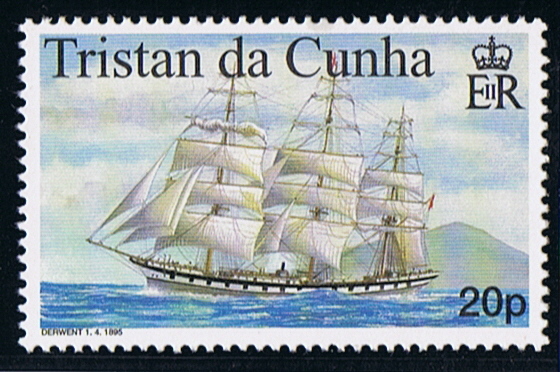
The iron full-rigger "DERWENT" was built in 1884 by the yard of McMillan & Son, Dumbarton, England for account of Devitt & Moore at London.
20 Oct. 1884 launched.
She was fitted out with a donkey engine, and boiler.
Tonnage 1.970 gross, 1.890 net., dim. 275 x 40.2 x 23.7ft.
The "DERWENT" was a very up-to-date ship, with numerous innovations. She was the first ship with cross steel topgallant yards and adopted rigging screws instead of deadeyes. Had a donkey boiler with winch barrels, a messenger connecting with the windlass and a condenser of the latest type. She was built to the specification of Capt. J.R. Andrew, her commander for the first 10 years.
She was a great example of a big full rigged ship. She had great sea-going qualities, good speed and an ample carrying ability.
The Last of the Windjammers Vol 2 by B. Lubock gives:
Full-rigger FITZJAMES, launched by Hamilton in March, 1902 had an race with "DERWENT"
I quote.
On her maiden passage she sailed from Glasgow on May 29 for Sydney, and Captain Fearon had an interesting race with the "DERWENT" from London, KILMENY from Sharpness, and the ACHNASHIE from Liverpool, which three ships had sailed five days ahead of him. After very stormy passages all four ships anchored in Port Jackson on September 9, within a few hours of each other. The FITZJAMES had therefore beaten the others by five days.
She worked the Sydney trade for 20 years for her owners. As a general rule during these 20 years, she carried general cargo and a few passengers to Sydney and wool back to London.
Her heaviest general cargo was 3.845 tons and she loaded about 8.000 bales of wool for her return trips.
She did not differ in appearance from the regular Clyde type of her date, but was a London ship and as such was run in true Blackwall fashion. Her crew always took a special pride in the painting of her fully carved lion figurehead with a great yellow main.
She carried on her maiden voyage a crew of captain, three certified mates, eight midshipmen or cadets, 12 apprentices, bosun, sail maker, carpenter, donkey man, and 14 hands in the fo'c'sle.
Sailed from Glasgow on Christmas Eve 1884 and wound up anchoring in the worst of weather at the Tail of the Bank, dragged her anchors, and the crew refused to do their duty. Capt Andrews could not be stopped by the crew or weather and the "DERWENT" got underway three times, all resulting in passing Tory Island and then being driven back. The weather was so bad that Capt. Andrews sought shelter at Queenstown, 11 days out from Greenock. Her advantage was taken to prosecute her insubordinate crew, who received sentences of from one to three months imprisonment.
She finally left Queenstown on 14 Jan. 1885 and reached Sydney on April 17, 93 days out with no trouble. Her return passage was also not too great taking 111 days to get home.
She was never one of the crack wool clipper ships of her day, but was always very steady. She was also a favourite ship with the shippers due to the perfect way in which she was operated, and the splendid state in which her cargoes were delivered - and she was never very far behind the crack clippers - always making the January wool sales.
Her best wool passage was 79 days in 1892-93. She had many other creditable runs - in 1897, the "DERWENT" reached port on the same day as the very fast THESSALUS, although she had left Sydney five days earlier. Her best outward passage was 69 days to Port Phillip in 1892. Capt. Andrews commanded her until 1897 and kept her almost totally free of accidents.
The most serious accident and the only one worth mentioning, occurred while on her way down the English Channel in May of 1897. The "DERWENT" was involved in a collision with a French trawler, which forced her to put into Plymouth for repairs to her bow and starboard side.
Capt. Andrews was succeeded in turn by the Captains W.W. Smith, H. de C. Wetherall and H.N.Forbes, the last of whom had her until she was sold to Chr. Nielson & Co. of Larvik, Norway, in 1904.
1914 New donkey boiler fitted.
1916 Sold to Wegger & Ohre, Sandefjord.
1920 Sold to C. Olsen, Arendal.
Thereafter she had a till 1925 different owners (i.e. A/S Gas Pall, Arendal) but all with C.Olsen as manager her master in this period was O.C.Olsen.
The "DERWENT" survived the WW I and continued to carry cargo into the early 1920's. In 1925, she shipped guano at Lobos de Tierra. Leaving Callao on 3 July, she reached the island at noon on the 7th, where she loaded for Charleston, South Carolina.
She began her last passage under sail on August 31. She proceeded by way of the Panama Canal, arriving in Charleston on 10 Oct. 1925. She could not pick up a cargo at this port and had little prospect of making her way financially in the future. Therefore, her owners reluctantly sold her to a Charleston firm for the sum of $ 10.250 and the ship was stripped and converted into a barge for coastal use.
1949 Scrapped.
Tristan da Cunha 1999 20p sg 647,
Sources: Info received from Mr. John D Stevenson. Have lost the other sources.
